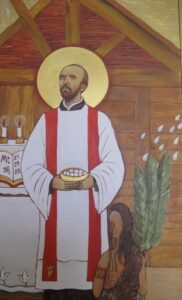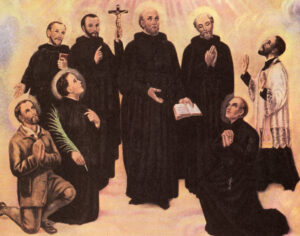
St. Anthony Daniel was a devoted and intrepid Jesuit priest and missionary and a martyr. Anthony (Antoine in French) was born to a merchant and his wife in 1601 in Dieppe in northern France. At age seventeen, he attended a university, where he studied law for one year and philosophy for two more. He discerned a call to the priesthood with the Society of Jesus, and joined them at Rouen in 1621. There, he was assigned to the Jesuit college, where he taught for four years. While at Rouen, he heard about the Jesuit missions in New France (modern day Canada) from the letters being sent home from the missionaries there. He also taught a young Huron Indian man who had been sent there to study. In 1627, Anthony went to the College of Clermont to study theology, and in 1630, he was ordained a priest. Father Daniel taught for two years after his ordination. His desire to be a missionary in the New World had only grown. He had met [St.] John de Brebeuf, who had surely told him of the successes in evangelizing the indigenous people.
CALLED TO MISSIONARY WORK
In 1632, Father Daniel and Father Ambroise Davost sailed on board the ship of Charles Daniel, Father Daniel’s sea captain brother. The trio arrived at Cape Breton Island in modern-day Nova Scotia. There was a French fort there, and Father Daniel and his companion spent a year serving the settlers there. They traveled to Quebec the following summer. In Quebec, Father Daniel spent a year mastering the Huron language. In 1634, Father Daniel, Father de Brebeuf and Father Davost traveled to Wendake in the Huron mission territory. North American Martyrs biographer Rev. John A. O’Brien aptly described the difficult journeys of these men as filled with “burning sun, dreary silences, exhausting portages, miserable food, swarms of mosquitoes, and endless paddling”.
At the mission, Father Daniel translated the Creed, the Our Father, and other prayers into the Huron language and he developed a special bond with the children, who were more open to his teaching. He formed a little choir of children for the chapel, using the prayers he had translated put to music. After some time, the children persuaded their parents to attend.

SUCCESS WITH CHILDREN
Because he had so much success teaching children, he was then sent to Quebec, where he was the head of a small boys school. Only a few of the boys, however, were allowed by their parents to continue their studies. The school closed, and Father Daniel and his remaining students went to the Three Rivers mission. He labored long and hard there to teach the boys. After learning reading and writing, they were taught basics of the Faith, how to be an altar server, as well as wood and carpentry skills. After a year, two of the boys became gravely ill with influenza. Father tended and nursed them night and day until their deaths. He became very ill with influenza himself, but recovered. His two surviving students had made great strides due to his teaching, and were firmly enough formed in the Faith to be able to evangelize their own villages. Father Daniel was then sent back to the Huronia Mission. He worked diligently in the mission villages, teaching, preaching, and making himself available to the people. This was not easy work, and the presence of smallpox made it worse. This dreaded disease was believed to have been brought by the French and it fostered much distrust of the priests. There was also widespread suspicion towards the religious articles used by the priests. In spite of this, Father Daniel went from home to home, tending to the sick as best he could and administering the sacraments whenever possible. Another great problem was the hostility of the Iroquois, who were frequently in battle with the Huron, and who were especially hostile to the French priests. One of Father Daniel’s former pupils, named Armand, was a special joy for him. He became a faithful lay apostle, was especially devoted to the Virgin Mary, and was a heroic warrior against the Iroquois. In 1641, Father Daniel was sent to Ste. Marie, where the Faith had been well established. This mission was located in modern day southern Ontario, about sixty miles north of Toronto. The mission village had a real chapel, which was beautifully furnished with Huron artwork. The Resurrection of Christ was joyfully celebrated at each Sunday Mass. Father Daniel served there until his death.
EXTRAORDINARY BRAVERY

On July 4, 1648, an attack of the Iroquois occurred. Most of the warriors happened to be on a trading visit to Quebec, so the village was very vulnerable. The strong palisades kept the attackers at bay long enough for Father Daniel to gather with all the villagers in the chapel. He urged the people to escape and to “keep the Faith to your dying breath.”. He baptized as many as he could and granted them general absolution. As the attackers broke through the palisades, he stepped out of the chapel, carrying a cross, and bravely told the Iroquois not to enter the chapel. The attackers were so astonished at his courage, they hesitated for several minutes, which allowed most of the villagers to escape into the woods. They then assailed him with arrows and threw his body into the chapel, which they then set on fire. He was forty-seven years old.
Father Anthony Daniel devoted himself entirely to his mission of bringing the Faith to the native people of Canada. He spent many long hours, day and night, in prayer and laboring for the welfare of his flock. He wrote many letters home to his superiors, reporting hope and taking his many hardships in stride. He was the first to die of the eight missionaries known as the North American Martyrs, one of whom was his friend, John de Brebeuf. This group of eight is commemorated together on October 19.
